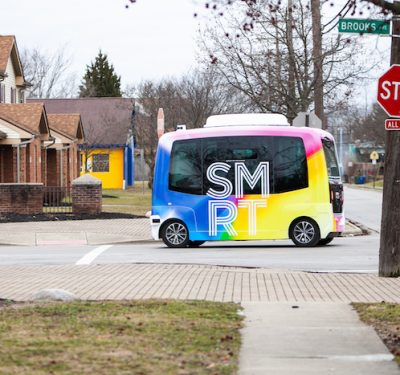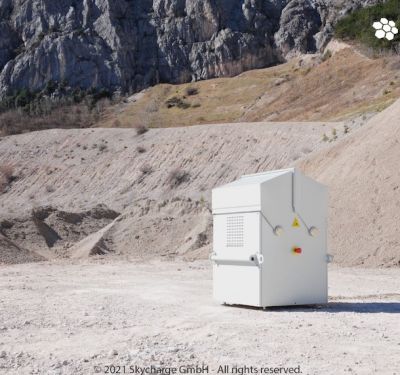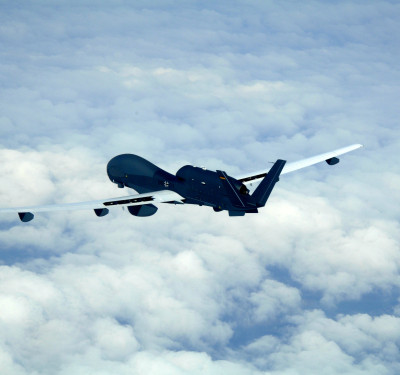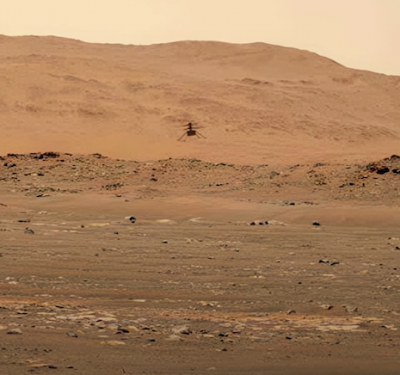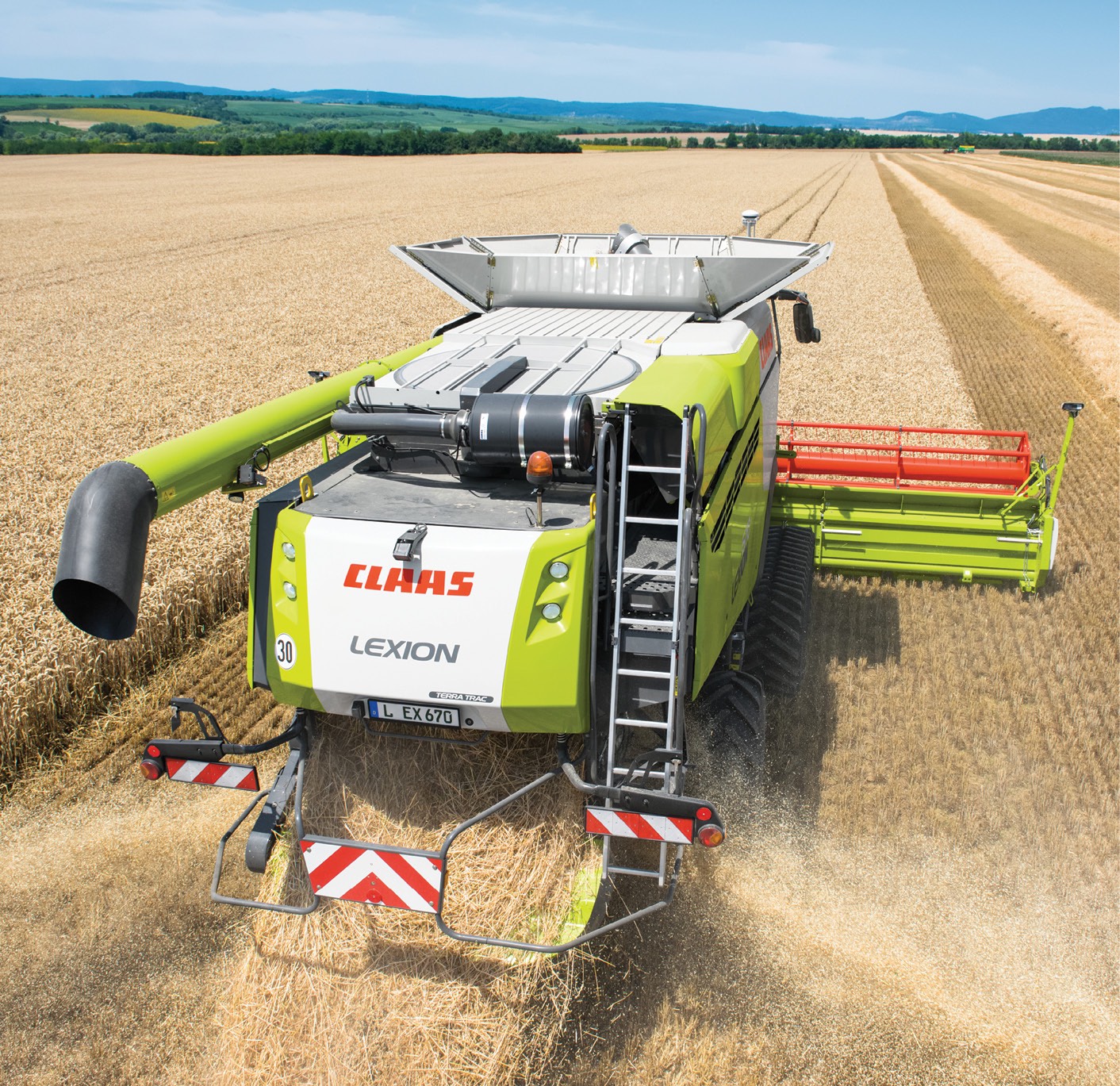
Unmanned systems’ global inroads are including European agriculture. GNSS for precision guidance of tractors and harvesters is already in place. More recent innovations include fully driverless and smart systems, while drones remain poised to fly.
ROBOTS IN THEIR PLACE
The experience of one Dutch company is instructive. Precision Makers is an up-and- coming manufacturer of automated farm systems. The company delivers two main products. One, a conversion kit called X-Pert, turns existing mowers and tractors into driverless machines. The other is a fully robotized, unmanned vehicle called Greenbot. Both systems enable automated precision operations, but while one has been successful in terms of sales, the other has not.
Precision Makers Business Development Director, Allard Martinet, told Inside Unmanned Systems, “Sales of our X-Pert conversion system have been very good. We started in 2008, first converting the Toro golf course mower, and then we expanded that into solutions for other vehicles. Today, there are more than 150 X-Pert converted vehicles running.”
The typical X-Pert conversion includes a specialized front bumper, a GNSS receiver, a terminal mounted inside the cab, an emergency stop button mounted on the outside, and radar, ultrasound and/or other sensors.
Interoperability and understanding of specific, local needs likely fuel X-Pert’s success. “What we do is integrate the system in such a way that the farmer can still drive it normally. All our electronics are mounted out of the way, like under the seat. In most cases all you can see from the outside is the GPS receiver and the obstacle detection system. That’s the bumper. The safety system we install depends on the application. On a golf course we mainly use LiDAR. In an orchard, we will have a physical sensing bumper, because a clump of tall grass might set off the LiDAR. So, we require physical resistance to trigger the safety shut-off in more overgrown areas.”
About the conversion process, Martinet said, “We can bring in a machine and within a week it’s back at the farm or at the golf course. Today’s tractors are often fully steer-by-wire, drive-by-wire, so the actual installation takes roughly two to three days. On a mower you have a mechanical drive train and a mechanical hydrostat, for example, so we need to put in more mechanical actuators to do what the driver would normally do.”
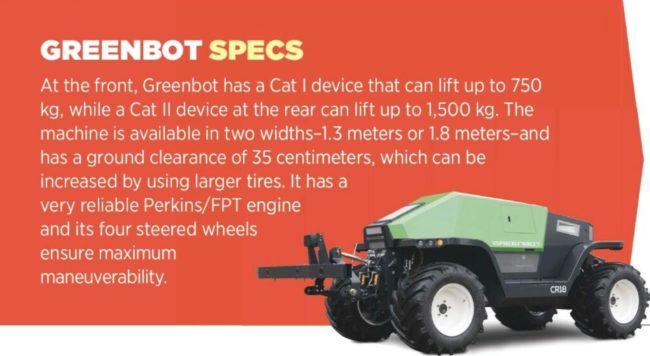
FULL AUTOMATION OPTION
Precision Makers’ other main product is a fully robotic vehicle, called Greenbot. Here, uptake has not been as rapid as with the conversion kit, and the reason for this, Martinet believes, goes back to basic European agricultural realities.
First, he described the Greenbot system: “When you look at a modern tractor, you see a lot of things that are there for the comfort of the driver: air conditioning, heating, the seat, interior lighting and displays, and you need to think about things like noise insulation. We wanted to leave out everything you don’t need if you don’t have a driver. It means you save on costs and eventually maintenance.
“We have a partner company called Conver. They make self-propelled vehicles and autonomous boats. They know drive trains, we know electronics, so we joined forces. They put together four wheels with an engine, and then we essentially added our conversion kit to that. There is no cab on top, no seat, no steering wheel.”
Martinet said his customers like the Greenbot and see it as a great system for the future, but not for right now. Remember the small and separated fields that are so typical in Western Europe? “The Greenbot is modeled after a 100-horsepower tractor, which means it is about the same size as a normal car,” Martinet explained. “The difficulty is, over here, the way the fields are arranged, farmers have to drive their tractors on public roads to get from one field to the next, which might be a few kilometers. But we can’t run driverless vehicles on our roads, so a driverless system needs to be hauled around on a trailer. This is really just introducing a new logistics problem.
“So, it’s a lot more sensible, for the moment, to convert your existing tractor,” Martinet said. “You can still drive it on the road, and then get off and let it run automatically in your field. We’ve sold a very small number of Greenbots in the last year and a half, mainly to specialized growers who have enough volume or land size to keep the machine in one place, dedicated to a single large field and a single specific application. We have a customer like that in Australia.”
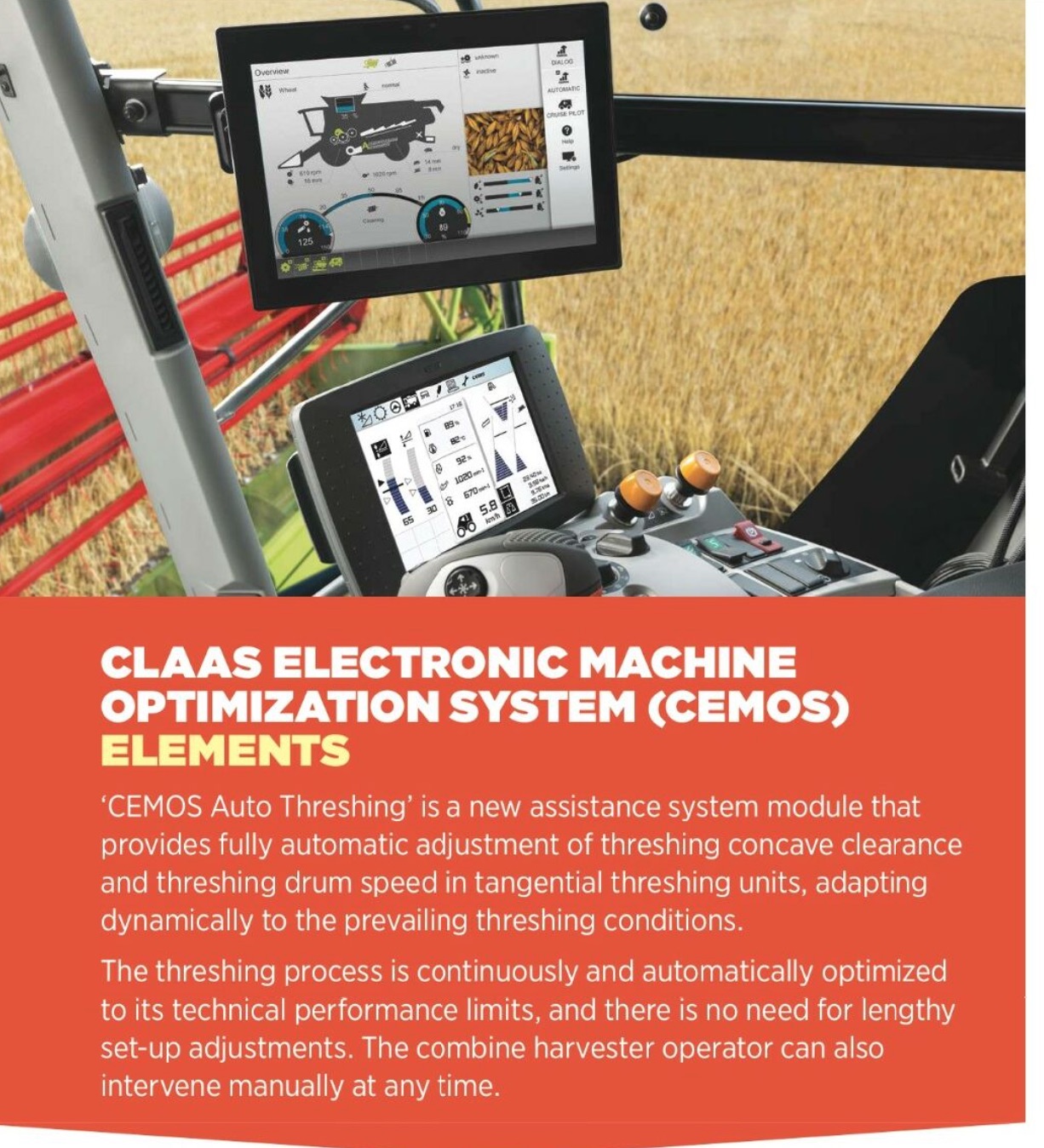
IMPLEMENTS AND IMPLEMENTS
European farmers also have their own particular way of using implements, that is the often large and complex machine elements that are attached to tractors and harvesters to do particular tasks such as planting, reaping or spraying.
“In the U.S. Midwest or countries like Australia, a large farm will have a fleet of many tractors, with each tractor set up for one task. So, the tractor with a planter attached is always used for planting, and you never change the implement. But over here, a typical farmer in the Netherlands has only one or two tractors, with roughly 25 implements being necessary for springtime operations, so implements are being swapped every few days.”
The switching of implements is time and energy-consuming in and of itself, and in the case where automated vehicles are being used, vehicle parameters, things like driving speed, the weight of the safety system, hydraulics control, all need to be reset each time for automated operations.
“The Dutch or European farmer sees a tractor as a sort of Swiss army knife,” Martinet said. “If they buy it, it needs to be able to do 90% of the applications and tasks. But we know that robots are really best at doing just one thing, over and over. If you need to do different tasks, and you need to change settings all the time… It’s like buying a welding robot for a car factory and then deciding it also needs to paint and assemble the parts.”
Finally, large farms in the U.S. tend to focus on a small number of crops. In Europe, the average farm, while smaller, raises a larger number of different crops. “In the U.S., dedicated corn growers will have everything they need and farm equipment set up for growing corn. In Europe, we’re moving to a potato field tomorrow, and on to onions the next day and sugar beets the day after,” Martinet said.
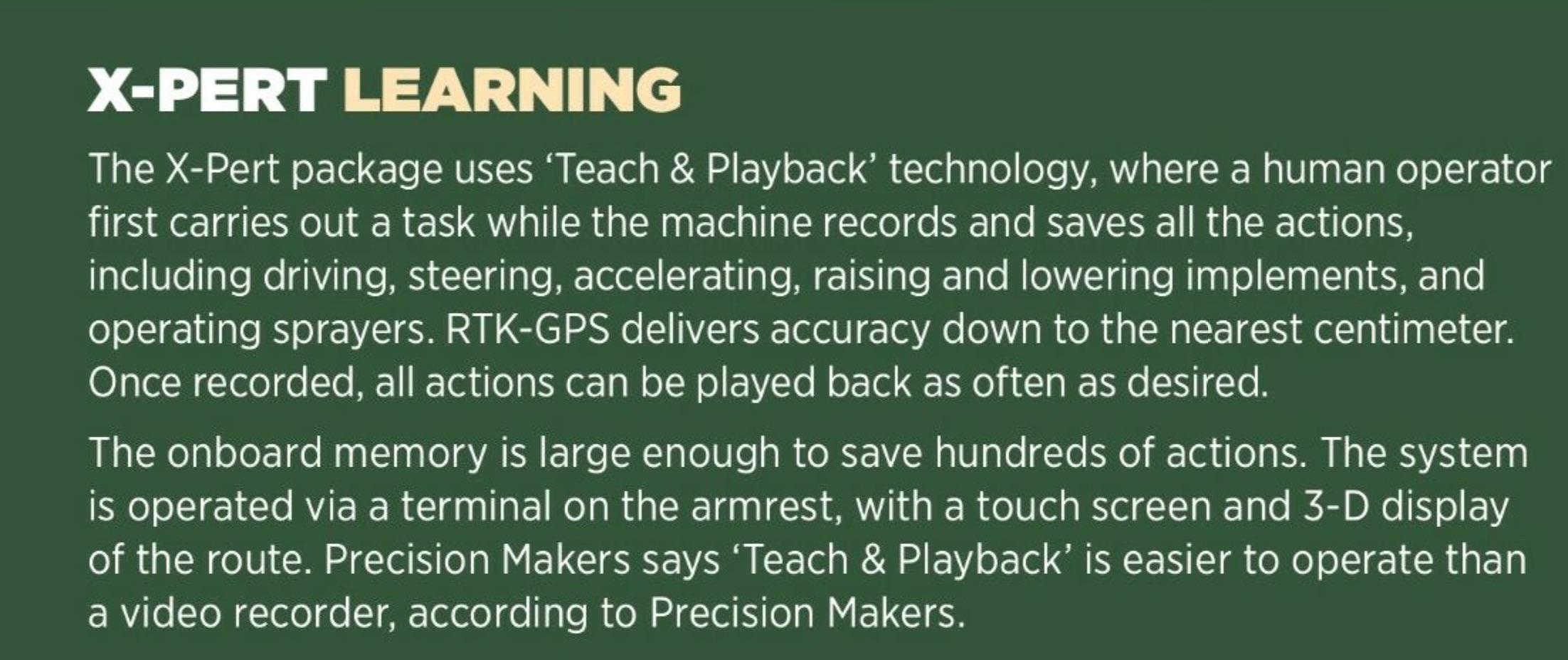
HELP FROM SMART IMPLEMENTS
Farmers in all countries are looking toward the introduction of newer and smarter implements. “Most of our traditional implements are not suited to be run by non-human systems,” Martinet said. “People are needed to monitor the quality of the work done by these implements. We need manufacturers to work on implements that can provide feedback by themselves, monitoring, for example, the quality of tillage, or how mowing is proceeding, things that a farmer or driver normally does with his own eyes.”
Martinet’s company is part of the Agricultural Industry Electronics Foundation (AEF), an international platform providing resources and know-how for the increased use of electronic and electrical systems in farming, including the development of tractor implement automation.
“We see there are a few manufacturers starting to supply cameras for their implements, to help assess some aspects,” he said. “For tractors without a driver, a smart implement will tell the tractor what to do, for example, to lift the hitch a little or lower it.”
CLAAS AND BIG-TIME AUTOMATION
One company at the leading edge of farming automation is the European manufacturer Claas, maker of the successful Lexion combine harvester. The company’s Deputy Head of Corporate Communications Frank Berning reiterated a concern: “For us, up to now, the human operator still has a role to play, mostly for safety reasons and for moving the machine from one field to another.
“On the field itself, most of our machines do work on a highly automated level. Depending on the operation, you can call that ‘nearly autonomous’. This includes machine optimization and adjustments to changing working conditions. A good example is the automated threshing system used on our Lexion.
“Under the ‘CEMOS Automatic’ umbrella,” Berning explained, “the Auto Threshing module is linked functionally with all the other assistance systems, including the Cruise Pilot, our automatic ground-speed control system. This interaction of different assistance systems is monitored and controlled via a central module.”
This makes Claas’ flagship combine harvester much more than a programmable robot. The different automated modules that make up the machine are coordinated by an intelligent algorithm. “It’s like a network of robots working together for the best outcome,” Berning said. “The threshing unit threshes as gently as possible and as aggressively as necessary. It does this in coordination with residual grain separation, cleaning and ground speed control. This arrangement means downstream automated operations are easier. Picture analysis of grain harvested, using onboard cameras, is another key element—is it clean enough? How much damaged or broken grain is there?”

WHAT’S THE DIFFERENCE?
So, we ask, what is the effect of this kind of technology on the bottom line and on productivity? “When it comes to performance, an average 10 percent improvement in productivity is a rough number to describe the potential of the system,” Berning said. “In addition to higher throughput, another effect can be better yield quality.”
Ten percent might not seem like a lot, but the fact is human operators of non-automated farm equipment are really quite good, so the starting baseline for comparing automated performance is quite high. “A keen driver is able to perform nearly as well as the automated machine,” Berning said, “just not over an eight- to 12-hour working day.”
Martinet at Precision Makers also said automation brings a small improvement in terms of production. “With an automated machine you get the normal advantages of a conventional tractor fitted with autosteering and GNSS, like no overlap, no skips, etc. But of course, you save the cost of a driver, which, in Europe, is relatively high.
“There are other ways to improve efficiency when you don’t have a driver. In your orchards, if it happens to be less windy at night then you can spray at night, and then your chemical application is better and you also get less evaporation. This sort of operation could be done with a driver but it is hard to find someone who wants to drive at night.” Similar advantages hold for golf courses, Martinet said. “They like our solution because they can mow at night and save the daytime for playing golf.”

EUROPE IS AHEAD OF THE UNITED STATES
The general feeling among European sources is Europe is ahead of the United States in the development and adoption of high-tech and automated systems for agriculture. “In Western Europe, resources like farmland are a limitation,” Claas’ Frank Berning said, “and this means that European farmers may be a bit more progressive with new technologies, because there is a real emphasis on getting all you can out of the land.”
“I would say Europe is slightly ahead of the U.S.,” Martinet said, “similar to in precision farming adoption. High-value crops and high land prices mean there is more money available to invest here in Europe, but the applications are also more challenging. For example, because we have to maximize production, our clients will not allow us to leave patches of land unseeded, even for 10 meters, because they lose money. Maybe the U.S. farmer will say you don’t have to spend time on the corners of the field, you can just make a round curve. Here in Europe we are used to planting even into the ditch, because our land is so costly. So that makes the job tougher for the automated system. It’s already difficult for a human driver, so it’s certainly difficult for a robot.”
Putting this all together, Martinet said he would expect to see the most advanced ideas, the best solutions coming out of Europe. At the same time, large-scale American farming is probably better suited to the wide adoption of robotics: “They have bigger fields, easier applications and don’t need to use public roads. This is where we should see the big commercial breakthrough for robotics.”
DRONES WAITING IN THE WINGS
Much has been said and written about the revolution promised by unmanned aircraft systems (UAS) in the agriculture sector. And, make no mistake, there are drone-based service providers doing good business, making lots of money, in moderate numbers, all across Europe. They’re delivering highly valuable information and analyses on everything from plant numbers to ground water content to precise field measurements.
What one would like to see is a drone in every barn, alongside every silo and hovering above every field. That kind of uptake could have a shattering impact on the drone manufacturing sector, engaging new waves of software developers and ultimately leading to real advances in terms of food production and environmental performance.
In that world, all legal barriers removed, drones will be deeply integrated within agricultural workflows. Just as the tractor is a fundamental element in today’s agricultural production chains, drones will be necessary and indispensible. This kind of scenario is already becoming a reality in the chemicals industry, for example, where one sees a shift from missions being undertaken by outside service providers to the industry itself bringing drones into its own in-house operational procedures.
We spoke to Robin Schardijn of Height Technologies, a global supplier of professional drone equipment based in Europe. He said, “To really see drones in large numbers like that, really like basic farm equipment, I think that needs a generation, because it needs a younger mind. The farmers right now, in our area, are used to working in a particular way. They are happy.
“Don’t forget that it was only a few years ago that they made the step to positioning, using a GPS connection for their harvesting and things like that,” Schardijn said. “Today, they have multi-constellation GNSS, and they are on their computers, checking the weather and all sorts of other information. Drone technology is something they are interested in, but all the associated sensor technologies and the way they collect data, it’s still quite new for a lot of people.”
While Schardijn may seem at first to paint a woeful picture, he and many of his colleagues are in fact far from fatalistic. The state of affairs must be seen as a challenge to overcome, and also as a massive opportunity to unlock.
Might not an innovative and even ingenious marketing approach be in order? Schardijn mused, “Suppose we give them a drone to try out. Let’s say, they use it for six weeks and then we talk further. Maybe we pre-program the drones to do some simple but extremely useful and impressive jobs for them. But we let the farmers operate them, let them play with them, really learn to use them. If you did that on a large scale, maybe you could speed the uptake. A lot of education is required. That’s what we’re talking about right now, in our company. How do you speed it up?”
The company or group or person who solves that puzzle stands to gain a great deal. Let’s just say it’s up to everyone, everywhere, by all means, to get cracking


